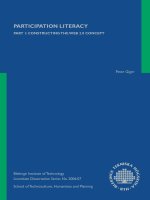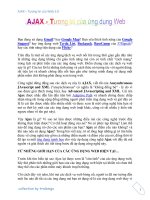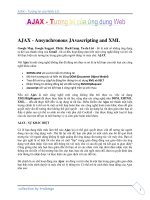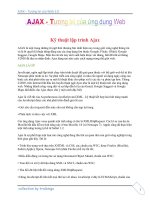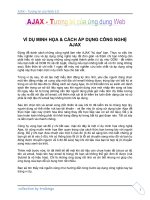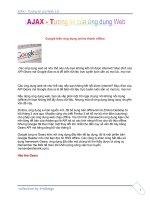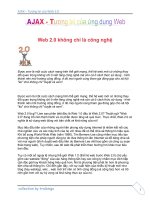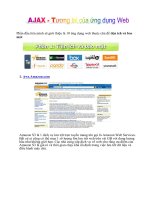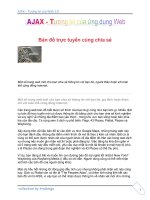PARTICIPATION LITERACY PART 1: CONSTRUCTING THE WEB 2.0 CONCEPT
Bạn đang xem bản rút gọn của tài liệu. Xem và tải ngay bản đầy đủ của tài liệu tại đây (1.27 MB, 107 trang )
Blekinge Institute of Technology
Licentiate Dissertation Series No. 2006:07
School of Technoculture, Humanities and Planning
PARTICIPATION LITERACY
PART 1: CONSTRUCTING THE WEB 2.0 CONCEPT
Peter Giger
This licentiate thesis is a piece of academic work
on the theme of Participation Literacy. The the-
sis concerns the Web 2.0 concept construction.
Web 2.0 is a new mindset on the Internet. The
main characteristics include “Web as a Platform”,
Collective Intelligence, Folksonomy and interfaces
built with lightweight technologies such as Ajax.
Web 2.0 is not only a technique, but also an ideo-
logy - an ideology of participation. A Web 2.0 ser-
vice is completely web based and generally draws
on open access. It includes tools for people to in-
teract within areas such as encyclopaedias, book-
marks, photos, books or research articles. All Web
2.0 services are web communities. A web commu-
nity is a group of individuals, linked together by a
network of social relations with some degree of
continuity. Community members learn from each
other and the knowledge base of the community
grows with every interaction. The core values of
Web 2.0 are democracy and participation.
The licentiate thesis is divided into four main parts
and two appendixes. The four parts constitute a
foreword, a reading guide, a conceptual and em-
pirical introductory discussion to the Web 2.0
concept, and fi nally a series of constructions ba-
sed on the Web 2.0 concept and the cyborg fi -
gure. Appendix I is a short conference paper called
Technologically Navigating Cyborgs. Appendix II is
a very short piece of fi ction, written in Swedish.
These appendixes comprise a background to my
interest in the Web 2.0 and the Cyborg concept.
ABSTRACT
ISSN 1650-2140
ISBN 91-7295-088-9
2006:07
PARTICIPATION LITERACY
Peter Giger
2006:07
Participation Literacy
Part I: Constructing the Web 2.0 Concept
Peter Giger
Participation Literacy
Part I: Constructing the Web 2.0 Concept
Peter Giger
Blekinge Institute of Technology Licentiate Dissertation Series
No 2006:07
ISSN 1650-2140
ISBN 91-7295-088-9
School of Techoculture, Humanities and Planning
Blekinge Institute of Technology
SWEDEN
© 2006 Peter Giger
School of Technoculture, Humanities and Planning
Publisher: Blekinge Institute of Technology
Printed by Kaserntryckeriet, Karlskrona, Sweden 2006
ISBN 91-7295-088-9
4
5
Table of Contents
Abstract
Acknowledgements
Prologue
Part I – A Reading Guide
The Structure
Transdisciplinarity
Feminist Technoscience and The Cyborg Figure
Approach
Some Issues
Disclaimer
Part II – Building the Concept Web 2.0
Starting a Position
Main Concepts
The Web as a Platform
Collective Intelligence
Folksonomy
Ajaxian Interfaces
Version 1 – for readers with no
programming knowledge
Version 2 – for readers with some
programming knowledge
Main Actors: Google and Yahoo
The Web 2.0 Document Model
Web 2.0 in Figures
Web 2.0 Off Shots
Identity 2.0
Dick Hart’s notion of Identity 2.0
Rosanne Stone and Multiple Personalities
The Identity Bank
The Urge for Anonymity
Intelligence 2.0 or Hybrid Intelligence
What about Law 2.0?
Library 2.0
Author 2.0
Research 2.0, Science 2.0?
Open Access
Open Peer Review
Collective Intelligence in research Environments
The Web as Platform
7
8
11
17
17
18
20
20
21
22
23
23
29
29
31
34
37
37
37
39
41
44
44
44
46
47
47
48
48
50
51
51
52
53
54
56
56
6
7
Web 2.0 Services
Ebay
Amazon.com Becomes a Tagging Community
Delicious and other Bookmark Managers
Bookmarking and Blogging with The Flock Web Browser
Last.fm and Pandora – or What is the Connection
between Esjorn Svensson and Goldfrapp?
CoComment (Blog Comment Tracker)
Writely – Online Word Processor
Summary Discussion Web services
Part II – Wrapping it all up
Part III – Starting The Discussion about Participatory
Literacy
Getting under The Skin
How I became a Native Cyborg
But What is a Cyborg, Really?
Anatomy
Web 2.0
ßà
Cyberspace
Participating Literacy
The sense of Irony and the Principle of Charity
Time Loss and the Document Concept
Plural Identities
Hybridity
Participation Literacy and an ideology
A few nal words
Appendix I: Technologically Navigating Cyborgs
Image 1: Surng in the Woods on a Mountain Bike
Image 2: Surng the Waves of the Internet
The Cyborgization Process
Navigation
Flow: The Link between Exisitence and Navigation
Appendix II Cyborgistoria (in swedish)
Glossary
References
56
57
59
61
65
66
68
69
70
71
75
75
76
78
79
80
80
82
82
84
85
86
86
87
89
89
90
90
91
91
93
95
99
6
7
Abstract
e licentiate thesis is a piece of academic work under the theme of /Participation Liter-
acy/. The thesis concerns the Web 2.0 concept construction. Web 2.0 is a new mind-
set on the Internet. The main characteristics include ”Web as a Platform”, Collective
Intelligence, Folksonomy and interfaces build with lightweight technologies such as
Ajax. Web 2.0 is not only a technique, but also an ideology – an ideology of participation.
A Web 2.0 service is completely web based and generally draws on open access. It includes
tools for people to interact within areas such as encyclopaedias, bookmarks, photos, books
or research articles. All Web 2.0 services are web communities. A web community is a group
of individuals, linked together by a network of social relations with some degree of continu-
ity. Community members learn from each other and the knowledge base of the community
grows for every interaction. e core values of Web 2.0 are democracy and participation.
e licentiate thesis is divided into four main parts and two appendixes.
e four parts constitute a foreword, a reading guide, a conceptual and empirical introduc-
tory discussion to the Web 2.0 concept; nally a series of constructions based on the Web 2.0
concept and the cyborg gure. Appendix I is a short conference paper called Technologically
Navigating Cyborgs. Appendix II is a very short piece of ction, written in Swedish. ese
appendixes comprise a background to the focus on the Web 2.0 and the cyborg concept.
8
9
Acknowledgements
First of all I want to thank my wife Susanne and my supervisor professor Lena Trojer. You have
both been a big help to me in dierent ways.
I also want to thank my family, friends and colleagues for all support: All of you at Techno-
science Studies because of our invaluable discussions and you at the Library because you create
an inspiring environment for new thoughts.
But I also want to thank all of you out there on the World Wide Web who participate in
the creation of our new world. Among you I especially want to thank the people who work
for open source and open access and you who actively produce intellectual material for me and
everyone else to experience.
8
9
In twenty years or so,
We might have funerals in two worlds
Peter Giger 2006
10
11
10
11
e licentiate thesis is divided into four main parts and two appendixes. e four parts constitute
this foreword, a reading guide, a conceptual and empirical introductory discussion to the Web
2.0 concept; nally a series of constructions based on the Web 2.0 concept and the cyborg
gure. Appendix I is a short article called Technologically Navigating Cyborgs, presented at
the EASST conference 2004 in Paris. Appendix II is a very short piece of ction, written in
Swedish. ese appendixes might be read as a background to my interest in the Web 2.0 and
the Cyborg concept.
e following story is about me and my way to the concept Web 2.0. In this story there is a
thread you could call the history of Social Soware. e thread begins in the 1940’s and ends
in the Web 2.0 concept. It is not my goal to give an exhaustive and neutral history.
In his article Tracing the Evolution of Social Soware, Christopher Allen traces the start of
the evolution of social soware with Vannevar Bush’s vision of the memex machine (2004).
Bush wrote: “A memex is a device in which an individual stores all his books, records, and
communications, and which is mechanized so that it may be consulted with exceeding speed
and exibility. It is an enlarged intimate supplement to his memory” (Bush, 1945). Bush’s
words sounds like my own eort to store all media in my computer. In 1945 though, media
was mostly books, since the music and lm industry were just in its infancy and computer
games, audiobooks and the Internet-era’s mountain of documents were still far away. It is
interesting to note that the hardest thing to store is in fact books. One reason is diculties in
nding an acceptable DRM-model for e-books; another has to do with our endemic habits
related to our long love for the book as a thing and not only a channel for information and
knowledge. Few of us can imagine curling up in the sofa by the re with a computer and some
sort of a reading device, instead of the good old idea of a book we love so much. Still, media is
Prologue
12
13
a very important factor in social soware, as much of the socialising is about communicating
navigational structures to dierent kind of media. Books are still the black sheep of digital
media. All eorts so far have failed to integrate books - in a large commercial scale - in the
family of digital media.
But now – in the beginning of 2006 – we might be on the verge of a paradigm shi in the
distribution and reading of books (Helm, 2005). e success of the Ipod concept has inspired
Sony to do something similar in the world of books . e reason I have for my belief is due to
several dierent, but cooperating phenomena. In a technical perspective there is an emerging
technique called E-ink, which promises great things for the printing industry. e E-Ink
technique creates text by electronically arranging thousands of tiny black and white capsules,
creating an experience remarkably similar to reading a printed page. e only time it drains
power from the battery is in turning pages, which means a battery will last for a very long
time – Helm says 15 books. In a social perspective we have a generation with new, digital
habits. For them, the e-book is probably going to be a natural step in the evolution of digital
media. e rest of us will also cave in to the digital alternative, since computers and other
communication technologies have grown to be a big part of our lives, compared to just ve
years ago. Lastly, we have the Ipod marketing experience fresh in mind. e Ipod – Itunes
distribution chain has succeeded in a great task in convincing buyers that their new digital
product has ‘invisible’ benets to the old analogue one, despite some seemingly convincible
advantages for the analogue product – you can rip it to your computer and have a digital copy
free of any restrictions. e price though is a heavy argument here. In Sweden, January 2006,
a digital cd costs approximately 50% of the price for a cd in one of the cheaper Internet shops.
is price depends on the competition to Itunes raised in the digital music industry around
the shi of 2005/2006. Helm says e-books in the Sony project are going to cost like a mass
market pocket book, and the reading device will be at the same price level as the Ipod. Only
time will tell if this project is going to nd the key to unlock the consumers’ good old reading
habits. We could talk about a new era when the digital book sale surpasses the sale of the more
than 500 year old Gutenberg book, though it is not impossible that the role of the text has
already passed and that the future belongs to other narrative forms. In twenty years or so, a
thesis might not consist of a single letter. Perhaps new academic forms will develop with images
and voices as point of departure.
Books and other traditional text formats have always played a big role in the evolution of social
soware. Books are the blueprint of storing information and communication. Sending letters
is the blueprint for long distance communication. Books and reading experiences, along with
music, lm and games, have always been an important subject in the messages of social soware.
I have dealt with e-book’s since the end of the 1990’s.
Returning to the 1940’s and Vannevar Bush’s memex device, there are parts in the text reminding
of social soware and the hypertext nature of Internet:
Wholly new forms of encyclopaedias will appear, ready-made with a mesh of associative trails
running through them, ready to be dropped into the memex and there amplied. e lawyer has
at his touch the associated opinions and decisions of his whole experience, and of the experience of
friends and authorities. e patent attorney has on call the millions of issued patents, with familiar
trails to every point of his client’s interest. e physician, puzzled by its patient’s reactions, strikes
the trail established in studying an earlier similar case, and runs rapidly through analogous case
histories, with side references to the classics for the pertinent anatomy and histology. e chemist,
struggling with the synthesis of an organic compound, has all the chemical literature before him in
his laboratory, with trails following the analogies of compounds, and side trails to their physical and
chemical behaviour. (Bush, 1945)
12
13
Bush’s term ‘memex device’ never gained wide acceptance and the whole concept was way
before its time. Aer Vannevar Bush, Christopher Allen jumps to the 1960’s and the rising of
ARPA (Advanced Research Projects Agency; formed 1958), which later formed ARPANET,
which in its turn led to the Internet. In 1962 Dr. J.C.R. Licklider was appointed to head ARPA.
He was going to have a profound inuence on the emerging academic subject of computer
science. In the article e Computer as a Communication Device Licklider says: “ere has to
be some way of facilitating communication among people without bringing them together in
one place” (1968, p 34). is single sentence says much about the last 50 years of endeavours
in the eld of computer technology.
In Sweden we had an education subject called ADB (Automatisk Databehandling), which
means Automated Computer Processing. e subject was called ADB from the early stages
of computer science to the Internet age in the middle of the 90’s – the subject is still called
ADB in some educational institutions. e concept automation originates from the ARPA
researcher Doug Englebart’s concept ‘augmentation’ from his seminal work: Augmenting Human
Intellect: A Conceptual Framework (1962). In the introduction he explains ‘augmentation’: “By
‘augmenting human intellect’ we mean increasing the capability of a man to approach a complex
problem situation, to gain comprehension to suit his particular needs, and to derive solutions
to problems” (p 7). Engelbart was among the rst to argue that in order to design tools for
augmenting the human intellect we must integrate psychology and organizational development
with advances in computing technology. is interdisciplinary approach disappeared later when
the term ‘augmentation’ became ‘oce augmentation’ and later in the 70’s ‘oce automation’
(Allen, 2004).
“Yet the number of successful product lines bearing the tag ‘oce automation’ did mean that
there was increased research money for creating new tools. One of the most important was a
project called Electronic Information Exchange System (EIES). [...] EIES was the rst major
implementation of collaborative soware” (Allen, 2004). In the paper Delphi Conferencing:
Computer Based Conferencing with Anonymity (1972), the founder of EIES, Murray Turo,
describes the system in terms reminding of modern collaboration systems: threaded-replies,
anonymous messages, polling, etc. ough Turo envisioned something similar to modern
collaboration soware, it was in the 80’s the implementations took o to form today’s
conception of social soware. In the late 70’s Peter and Trudy Johnson coined the term
‘Groupware’ as “the combination of intentionally chosen group processes and procedures plus
the computer soware to support them” (Johnson-Lenz, 1989). e term groupware existed
basically in academic settings until the end of the 80’s, when Robert Johansen wrote the best-
selling business book Groupware: Computer Support for Business Teams ( Johansen, 1988).
e surge from the book transformed the concept of groupware from a relatively unknown
term which only lived in certain academic contexts, to a buzzword in marketing and a in a
broad techno sensitive public. is led to an interest in the concept from companies such as
Lotus and Microso; both Lotus Notes and Microso Outlook have been called Groupware.
You can keep that in mind when you read about the concept Web 2.0 below.
In the 1970s there was the Electronic Information Exchange System (EIES). According to
Christopher Allen EIES was the rst major implementation of collaborative soware (2004).
EIES had many of the features of BBS- style community soware that we see today, but in a
primitive form.
From my viewpoint, it was in the 1980’s everything happened at once. e PC was introduced
to the world. Groupware continued to evolve. New social soware approaches were developed.
Among them a technique called Collaborative Filtering. e term was not actually expressed
14
15
before 1992 – that I know of. It was coined by Dave Goldberg and his colleagues at Xerox
PARC (Goldberg D, 1992). It was also in the 1990’s the technique became known in a wider
context. With Collaborative Filtering, we have the real starting point for the Web 2.0 concept.
I will follow this line of development soon, but rst I want to introduce my own starting point
in the world of computers.
It was in the 1980’s the computer became a real concept for me. e rst computer I owned
was an 8088 PC in the beginning of the 1980s. is was the time just before the hard disk and
the computer mouse. Advanced computer graphics was two lines crossing each other on the
black screen. Still, this PC was sensational. Earlier I had used computers such as Commodore
and ABC 80 and older persons I knew talked about computers with the soware on punch
cards. By comparison with that my PC seemed very advanced. My interest focused on art and
literature in those days, and in some way I had persuaded myself that a computer would add
something to these activities.
My approach to literature was to follow certain concepts through one or several authors’ work.
In literature research these concepts are called themes, motifs, symbols or metaphors. It would
be splendid to get masses of text into the computer and do comparable searching to nd spots
for closer reading and thereaer nd relations between dierent concepts over space and time.
As if this was not enough, I wanted to nd a way to transfer my interest for oil painting into
the computer. When I had spent some time with this PC I understood my intentions were a
good laugh, nothing more.
e next generation of computers I owned was called 286, aer the processor name. Now the
computer had mouse, hard disk and a rudimentary Windows. is was the rst computer I
worked on which could deliver things I did not have to program myself – objectively speaking
this was not true. Perhaps the 286 computer in the end of the 1980’s is the rst in the generation
of computers we are using now in 2006. Only 15-20 years have passed and now I feel strongly
that we are on the verge of a new step in the man-computer evolution. is step is based on
a wide array of things. Some of these things are about hardware and soware, but the most
important things are about people. Using distance as metaphor, you could say that the distance
between man and computer has been closing up for every year since the rst computer was
“born”. I use the word cyborgization process to describe this closing gap between man and
computer. I feel quite assured that some day man and computer will be integrated. I am not
sure the integration will be physical though. I do not think our skin and the air around us is
such a strong border as you might believe. I do not think a tool is more me just because it is
operated into my hand and connected to my brain. I do think feelings like love, joy and passion
are at least as strong connectors as articial connections to my brain.
In the middle of the 1990’s I went on a new journey with my travel mate, the computer. I
discovered the path I am onto right now; the path of Web 2.0. is was almost ten years
before the concept Web 2.0 was coined. Still, the concept I met was to be the core in Web 2.0 -
Collaborative Filtering. Collaborative Filtering is basically a set of algorithms, which use people’s
choices, habits and paths to create recommendations. If I show the system I like a certain music
artist, I might get recommendations on similar artists. e point of collaborative ltering is to
create relations between users with similar preferences in order to present recommendations.
I saw, and still see, Collaborative Filtering as a start of hybrid entity comprised by esh, metal
and metaphors. I saw collaborative ltering entities turning into a completely dierent way of
life in a near future. Aer a time, these rather romantic notions were divided in two streams
- one stream of praxis and one of theory. ese streams were intertwined but none the less
distinguishable. One led to a more user oriented urge to use these practices in my daily life
14
15
and one stream led to a more epistemological interest. ese streams are still alive in this thesis
and you will notice them.
Two of the many articles trigging my interest were David Maltz’ and Kate Ehrlich’s Pointing
the way: active collaborative ltering (Maltz, 1995) and Running Out of Space: Models of
Information Navigation (Dourish and Chalmers, 1994). Dourish and Chalmers lead to the
next step in my evolution towards Web 2.0. It is not about Collaborative Filtering, but Social
Navigation. ese two subjects lived parallel lives for many years, and still do to some extent.
My notion of the dierence between these two computer science subjects is that they are two
sides of the same coin. Collaborative Filtering has evolved to be mostly about mathematics and
programming, while Social Navigation is mostly about interface and collaboration research
(HCI and CSCW)
1
. Since I do not have disciplinary knowledge about these academic subjects,
it is self-evident that these thoughts are only my personal view. Especially Social Navigation
is an interdisciplinary research subject, which also includes actors from information science,
articial intelligence, social psychology and so on. e book Designing Information Spaces:
e Social Navigation Approach (edited by Kristina Höök, David Benyon and Alan J. Munro)
(2003) gives a very good overview of the eld.
Both Collaborative Filtering and Social Navigation are at the core of the Web 2.0 mindset.
But aer some time I felt stuck. I could not nd the political, ideological dimension I needed
to nurture my interest. is was about 2002-2003. At this time I started my graduate studies
at Technoscience Studies at Blekinge Institute of Technology. I already worked as a librarian
at the same university college and my aim was to nd a form for these practices to act together
in some way. It was more dicult than I could imagine and this diculty was only inside me.
Both the Library and Technoscience Studies are into horizontal thinking. e transdiciplinary
approach at Technoscience Studies was one of the things that attracted me most about going
into graduate studies.
e rst text I read in my graduate studies was Donna Haraway’s book Simians, Cyborgs
and Women (1991). is book includes her most famous texts A Cyborg Manifesto: Science,
Technology, and Socialist-Feminism in the Late Twentieth Century and Situated Knowledges: e
Science Question in Feminism and the Privilege of Partial Perspective. ese articles are among
the rst of Haraway’s major publications and they are still the most well known. ey have got
wide recognition and both articles are published on the Internet
2
. ese articles echoed in me
and found epistemological friends among other thoughts in philosophy and literature I had
pondered on many years before. e Cyborg gure and the thought of knowledge as situated
are still two of my most dear companions.
e next concept in my evolution towards the Web 2.0 concept was folksonomy. is was
sometime around 2004/2005. At rst it passed me by as an interesting phenomenon, but it
did not really sink in. But somewhere by the end of the summer 2005 I saw the word briey
written in a mail from one of my colleagues (anks Anna!). It trigged something in me even
though I hardly remembered what it meant. Folksonomy belonged to the same context as
Collaborative Filtering and Social Navigation, but it had what I was searching for - ideology
and politics. It was about democracy and non hierarchical thinking. I will return to folksonomy
in more detail later.
Directly aer I started to do research about folksonomy I bumped into the concept Web 2.0.
Web 2.0 engulfed the concept folksonomy, but contained even more exiting possibilities. Web
1
HCI means Human Computer Interaction; CSCW means Computer Supported Cooperative Work.
2
A Cyborg Manifesto:
Situated Knowledges:
/>16
17
2.0 is what I wanted Collaborative Filtering and Social Navigation to be, but could not nd
in those concepts. It is a new way of thinking about information, knowledge and people. I am
quite sure it will change the view of many of our most dear concepts such as the document
and the le, but it will also have impact on more profound questions such as what is a human,
what is identity and what is knowledge.
Finally in this foreword some words about knowledge production. I want my knowledge
production to be created in application (and implication) contexts, and not in a framework of
social norms. I always had trouble understanding the term method, since I interpret it as “how”
in the context of a particular situation, and not “how” according to a readymade framework.
In this understanding, the concept of transdisciplinarity is essential. is is important for the
understanding of my work. e concept transdisciplinary does not only address academic
disciplines. It is also questioning borders between academic settings and the society we are
integrated in. Knowledge wants to be free. Knowledge does not want to be contained within
borders like this. I do not believe that traditional borders and frameworks produce better
knowledge. Neither do I think established methodological frames can lter knowledge from
unnecessary context. Context is rarely unnecessary and points of context can only be removed
by addressing the context as a whole. Knowledge production should be distributed by thinking
of society as an integrated whole, and not as separate parts as government, industry, academy
and subparts as natural science and social science. Transdisciplinary is both a working layer and
a distribution system for knowledge. (Gibbons, 1994), (Nowotny et al, 2001)
16
17
Every journey needs its travel guide, but some journeys might be easier if you have a helping
hand guiding you through and contributing to your experience. is reading guide is my
contribution to making our relation in the reading process of this licentiate thesis as constructive
as possible.
The Structure
My graduate work is a series of two parts: Part 1 is this Licentiate esis and Part 2 is the
main work. e series of the two works is called Participation Literacy. e Licentiate esis is
therefore a work in itself, but at the same time it functions as a base for the “big thing” later on.
is structure seemed natural since the area I am writing about is so new that very few know
anything at all about it. is called for a special structure in the licentiate thesis.
Part I – A Reading Guide is about the context of this text: my background, the texts’
own background, my approach and how the structure works. It is about the roots and the
surroundings of this text. is part is short but quite essential and cannot be cut o, if my
intentions are going to have a chance in the communication.
Part II – A technology based analysis of the Concept Web 2.0
is a conceptual approach to
an emerging trend on the WWW. is is an analysis of something you could call a new mindset. In
social sciences new mindsets are oen rhetorically created, like the discourse of postmodernism vs.
modernism. In some senses the discourse of Web 2.0 vs. Web 1.0 is built up in the same structure as
the postmodernism discourse. e dierence is that the Web 2.0 discourse is limited by its natural
borders: the protocols and standards building up the ICT (Information and Communications
Technology) layer of the world. The Web 2.0 discourse is also very new and immature. The
Part I - A Reading Guide
18
19
participants in the discourse have just started to formulate the concept and this formulation is
a critique on Web 1.0 environments. e critique is mostly implicit though, and Web 2.0 has
inherited many of the negative structures of Web 1.0. First and foremost both the discourse and
practises of Web 2.0 include mostly young to middle-aged western males. Since it is a about
expensive technology with broadband Internet connections as the very grounds of existence, it
excludes huge amounts of people with low income or people living in areas outside the “broad
band belt” of the world.
Despite these problems belonging to practically all technology, I see exciting possibilities over
the next decades. I will not pretend the thesis to be a detached and objective analysis. I do not
believe in detached research. For me technology can never be detached. Both technology and
research are ideology. See (Latour, 1998).
Finally, technoscience is more, less, and other than what Althusser meant by ideology: technoscience
is a form of life, a practise, a culture, a generative matrix. Shaping technoscience is a high-stakes game.
(Haraway, 1997)
Technoscience is a game, a very serious game and gaming is not a detached activity cleansed
from ideology.
My aim in this part is to start a discussion of Web 2.0, in areas where the concept is not rooted
yet. My target group is both the research community in large, and professionals in the society
as a whole. With professionals I mean persons working in the world of education, librarians,
computer specialists etc. is part is meant to be a technological analysis and the beginning
of a discussion of a phenomenon in technology and society. is phenomenon called Web 2.0
will probably change our view of ICT in the years to come.
e knowledge in this Part is absolutely essential to understand the discussion in Part III. If
I had not written this part, Part III had been impossible. Still, this part is written to stand for
itself.
Part III – Starting the discussion about Participation Literacy is a construction based on
stories in Part II and technoscience theories and methods. In this part I construct the Native
Web cyborg. is gure is very much about irony and is supposed to bridge the gap between
humans and technology. My cyborg gure, though, is not based on human esh meeting
the synthetic materials of technology. My cyborg gure is more about the relation between
humans and the synthetic space we construct for ourselves. My guration does not start with
the assumption that technology has to be wired to our nervous system to be called cyborg.
ere are other strong connectors, namely the social.
is part represents the closure of the licentiate thesis and the beginning of my main thesis. I
end the construction of the Web 2.0 concept and start the discussion of its complex theoretical
layers. e very last section before the appendixes deals with participation literacy more
specically.
Transdisciplinarity
As I mentioned in the foreword, the transdisciplinarity approach is essential for me. Some
knowledge of the transdisciplinary is also essential for your understanding of this thesis.
ere are several concepts for describing border crossing qualities in research. Trojer (1997),
(2001), lines them out as follows:
Multi-disciplinarity or pluri-disciplinarity means that two or more disciplines are involved
to solve a specic research problem. e level of integration and synthesis among the disciplines
is sparse. is mode of research does not provoke the participating disciplines.
18
19
Interdisciplinary research means that it is impossible to divide the research problem into
clearly dened disciplinarily parts. e level of synthesis is noticeable, both methodically and
theoretically. is mode of research is more provoking to the mother disciplines, since the
impact of disciplinary change is obvious.
In Transdisciplinary research, the solution of the research problem is placed beyond disciplinary
thinking. Transdiciplinary research creates and maintains its own framework of methods and
theories in the specic research context.
In e Potential of Transdisciplinarity, Helga Nowotny place transdisciplinarity in the context
of a concept called mode-2, or a new way of thinking about research (2003). She identies
an array of attributes for the concept mode-2 and, transdisciplinarity is a key actor in this
concept:
e third attribute of Mode-2 is transdisciplinarity. If we had intended to use the term´ multi-
disciplinarity or pluri- disciplinarity, we would have done so. Rather, we have chosen transdisciplinarity
for a reason. What we were trying to convey by the notion of transdisciplinarity is that, in Mode-2,
a forum or platform is generated and it provides a distinctive focus for intellectual endeavour, and
it may be quite dierent from the traditional disciplinary structure. In a Mode-1 system, the focus
of intellectual endeavour, the source of the intellectually challenging problems, arises largely within
disciplines. is may still go on, but other frameworks of intellectual activity are emerging which
may not always be reducible to elements of the disciplinary structure. Rather, it is in the context of
application that new lines of intellectual endeavour emerge and develop, so that one set of conversations
and instrumentation in the context of application leads to another, and another, again and again.
(Nowotny, 2003)
In the New Production of Knowledge(1994), Michael Gibbons et al. created the concept mode-
2 to describe a change in the research society. Mode-2 is not to replace mode-1 (traditional
research). Mode-2 is dierent in most aspects. Problems are not set within a disciplinary
framework, but operate in the context of application. It is transdisciplinary rather than mono-
or multi-disciplinary, and carried out in non-hierarchical, transient, heterogeneously forms.
Mode-2 is not carried out primarily within university structures. It involves close interaction
of many actors, which means that knowledge production is becoming distributed and more
socially accountable.
All this is very important for my dialogue and the mode-2 approach has many similarities with
the Web 2.0 concept. ese concepts have been created for the purpose of describing a change
in a technosocial network. e Web 2.0 concept is also transdisciplinary as it is not conned
to the computer science community, but has given birth to new thoughts and applications in
many areas, such as within the eld of information and library science. Web 2.0 is likewise non-
hierarchical, heterogeneous and transient. For me both Web 2.0 and mode-2 are phenomena
induced by a poststructuralist society.
Mode-2 knowledge production is important in my context, and can be used as an explanation
to the dierent parts in the thesis: Part II which is aimed more to professionals and Part III
which is aimed primarily for a research context, where the cyborg gure as a rhetoric tool does
not seem too alien.
I wish to stress two issues. One - this text is not an argument against disciplinarity and mode-
1, it is an argument for transdisciplinarity and mode-2 as a basis for the understanding of
Web 2.0. My way of viewing myself and society is in the context of the contemporary and the
postcontemporary. I agree that we must know the past to be able to form the future – perhaps,
but I think there is an imbalance in society – and research – to deal more with the past than
the future, when it should be the other way around. I think this view is a prerogative to be able
to understand the mechanisms behind this text.
20
21
e other issue I want to stress is about the soapy border between science and research. Mode-2
is not about science. Mode-2 is about research.
In the last century and a half, scientic development has been breathtaking, but the understanding
of this progress has dramatically changed. It is characterized by the transition from the culture of
“science” to the culture of “research.” Science is certainty; research is uncertainty. Science is supposed
to be cold, straight, and detached; research is warm, involving, and risky. Science puts an end to the
vagaries of human disputes; research creates controversies. Science produces objectivity by escaping
as much as possible from the shackles of ideology, passions, and emotions; research feeds on all of
those to render objects of inquiry familiar. (Latour, 1998)
is quotation from Latour is so important that I am actually citing it two times in this text
– repetition is a rhetoric tool that is oen misunderstood.
Feminist technoscience and The Cyborg gure
is thesis is a technoscience construction, which will be more explicit in Part III, where I will
also discuss my approach to technoscience. In this short section I will make a note about the
gender approach in the LIC.
One of the two general focuses in gender research is the knowledge processes, theories and
methodological approaches of science. It is this identication that is of particular interest at a technical
faculty and which is one of the main starting points for our technoscientic gender research.
e other main general focus of gender research is women / men / sex / gender / gender and power
relations. However, gender and gender relations are not as self-evident as objects of study within
technoscience as they are in, say, social science.
3
As Lena Trojer writes in the quotation above, one of the main agendas for gender research
within a technical faculty is about epistemology (see i.e. Wagner 1994, Barad 2003, Haraway
1997). is thesis operates within that frame. Men and Women are not primary categories here,
knowledge is. e base, context and practises of that epistemology are presented and discussed
in Part II. e construction is done in Part III by creating the Native Web Cyborg gure. I will
be more explicit about technoscience and the cyborg gure in Part III.
Approach
I have always had a conceptual approach to intellectual material, which might be seen as a
background for this text. I oen think of language as a multidimensional map of concepts with
material-semiotic relations connecting them in various ways. Concepts are constantly in the
process of construction. A concept’s denotation is embedded in a multitude of connotations.
I believe this tension between denotation and connotations is very productive. My approach
to the Web 2.0 concept starts from this point of view. Another researcher with a preference
for concepts is Robert Young.
Looking at the value laden aspect of scientic concepts has become a fruitful line of enquiry among
critical historians of ideas. is opens the door to looking at the ways ideology — value systems
representing power relations — constitute research agendas and valorise key concepts. Functionalism
in the human sciences is an excellent example, as a number of scholars have shown. Donna Haraway
has done so with great force and eloquence in her magisterial Primate Visions: Gender, Race and
Nature in the World of Modern Science and her essays, Simians, Cyborgs and Women: e Reinention
of Nature. She is, in my opinion, the foremost practitioner of the analysis of scientic concepts which
touch on our humanity, and her writings show the integration of science, society and ideology. ey
are conceptual research at its best. (Young, 1995)
3
/>cument
. Viewed: 2006-03-26. Cache 0031
20
21
Reading Young’s article was some sort of conrmation for me. Here I met another researcher who
used the concept approach explicitly and saw Donna Haraway as one of the great in conceptual
research. is is a mirror of my thoughts when I read Haraway the rst time. A large part of her
approach is to create concepts like the Cyborg, Situated knowledge and the Coyote and discuss
them in the context of application. I view concept research as an application of semiotics.
Since I am an information professional the concept approach is closely linked with information
searching. e constant search for information is a substantial part of my research process.
Information searching is a conceptual process. Search terms are conceptual doors to the
information and knowledge. Advanced (i.e. Boolean) information searching is a simplistic
mimic of our rational thinking process. We identify the concepts, the relation between them
and the context they belong to.
Some issues
1. is might shock you if you have a traditional view of a librarian, but I nd paper based
information hopelessly dysfunctional. Traditional ways to publish research texts are by
paper and now also PDF. e PDF format acts mainly as a source for printing. Both these
forms are very static. I would like to se the main form of research texts published in polylogue
environments similar to wikis, where research texts are viewed more like evolving collaboration
entities with the original research text as a start of collaborative knowledge. I do not mean that
everyone should have rights to edit the text itself. A Web 2.0 document is much more than a
traditional document with its hyperlinks, comments, rankings, trackbacks and pingbacks.
is text is a Web 2.0 document. If you are reading it in its primary environment on the Web,
it will be hyperlinked and open for participation (discussion). If you are reading a closed version
such as the paper book or a print out of the PDF, I urge you to read it actively in close contact
with a Web environment. Links are provided in one way or another in all versions. Words
you do not understand should be easy to look up in a search engine or encyclopaedia. If you
are suspicious of my interpretation of a word, please look it up and participate with your own
understanding. By participating in this way, you actively promote the spirit of this text.
2. is thesis works with dierent styles, all from the very banal to the very complex. ere are
two reasons for this. 1) is is how I am. 2) e Web 2.0 practices and theories move along this
wide continuum. It starts with seemingly trivial functions in soware practices. e usage of
these practices induces a network of increasingly complex theories. I am only in the beginning
of this process.
3. My argumentation might be too enthusiastic sometimes. is is also who I am and the
context of this text would be diminished if I tried to hide this. I want my person to be visible
in the text, since I am a signicant part of the context.
4. ese issues are based on my view of Situated Knowledge (Haraway, 1991). Knowledge is
always contextual and situated. is means that I cannot erase myself from the text. I am always
in the centre of my text.
5. Some wise transdisciplinary researchers have a Glossary, for example John Law (2004).
I guess this is almost necessary since some transdiciplinary texts address a wide community
of researchers, not necessarily with the same terminology as the author. Instead of having a
glossary in the paper and PDF forms, I am going to spend my energy on the primary wiki form,
which will be hyperlinked both within my own text and the outside world. e hyperlinked
research text is a form, which is starting to mirror the nature of research texts. Research texts
have always been hyperlinked in an abstract sense with its explicit quotations and references,
and the implicit intertextual qualities. ere will be more about Intertextuality in part III
.
22
23
6. Since I am using a lot of material from the Web, I have saved every cited page in PDF format.
is is because the Web continuously changes. If you want to see the original page I quoted,
just mail me the cache number, i.e. cache 0001. e cache number is stated in relation to the
reference in the footnote or in the reference list.
Disclaimer
The Web 2.0 concept and all its subconcepts work in the context of technology and
obviously have the same shortcomings as other forms of technology. Web 2.0 is the front
of Web technologies and therefore should have more shortcomings than more established
technologies – though I am not sure that is the case. We also have to take in consideration
that Web 2.0 technologies are in the front of social interaction through technology. All this
gives shortcomings as:
• Broadband racism (those without broadband are out of the picture).
• Women are few.
• Elderly people are few.
• Poor people cannot aord the equipment.
• Technology in itself can be scary.
• Some examples of this technology might not be easy to use for disabled people.
• If you are a dyslexic, you might nd this technology not to be perfect for automatic
reading applications.
• Since participation in the Web 2.0 sense is an addition to your already packed
calendar, you will obviously have to cancel other tasks. But that is the nature of life.
We all have to choose :-)
I hope this thesis will inspire other researchers to address these kinds of questions, either by
criticising this thesis or in Web 2.0 criticism articles. Without critique research is pointless.
22
23
Starting a Position
Denitions are means to end discourses; someone in power is telling those with less power
that the discussion is over. Since language always changes, there is no way to stop a concept in
time and space, from changing, from developing. All denitions are therefore situated to the
context belonging to the person or the organization standing behind the denition. As long
as we do not take denitions too seriously, they can be valuable as building blocks in one’s
own idea of a concept. With these words in mind you might get something out of these short
denitions of the concept Web 2.0
Web 2.0 is a series of best practice oriented to assist people create dynamic websites, which allow them
to easily connect with various communication, services, social and web tools. at is the foundation
of what web 2.0 is. (Mann, 2006)
Web 2.0 is the network as platform, spanning all connected devices; Web 2.0 applications are those
that make the most of the intrinsic advantages of that platform: delivering soware as a continually-
updated service that gets better the more people use it, consuming and remixing data from multiple
sources, including individual users, while providing their own data and services in a form that allows
remixing by others, creating network eects through an “architecture of participation,” and going
beyond the page metaphor of Web 1.0 to deliver rich user experiences. O’Reilly, 2005B)
If we picked out the keywords (or tags) from these denitions we would get a starting point
for a wider discussion about the concept.
Part II – Building the Concept Web 2.0
